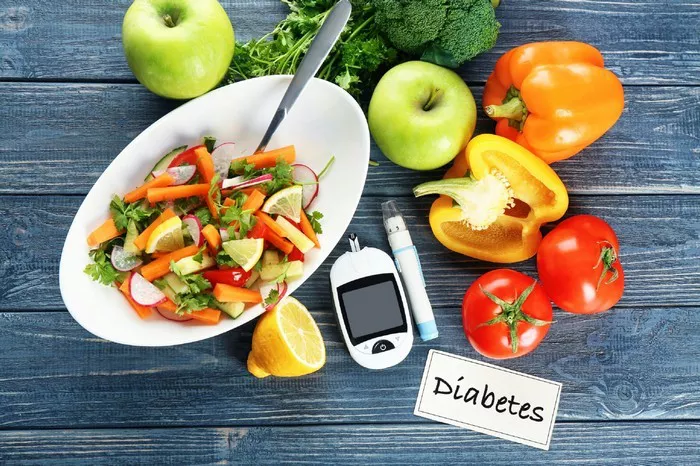Living with diabetes requires making conscious decisions about food choices that can have a direct impact on blood sugar levels and overall health. Type 2 diabetes, the most common form of the disease, is characterized by insulin resistance or the body’s inability to produce enough insulin to maintain normal blood glucose levels. In addition to proper medication management, a well-planned diet is key to controlling blood sugar and managing the condition.
For diabetics, the food we eat plays a critical role in regulating blood sugar, managing weight, and preventing complications associated with diabetes. Choosing the right foods can help stabilize blood sugar levels, improve insulin sensitivity, and promote overall health.
In this article, we will explore which foods are safe and beneficial for diabetics, emphasizing those that can help keep blood sugar levels in check, improve metabolic health, and reduce the risk of complications associated with the disease. Understanding the characteristics of these foods is crucial for anyone living with diabetes, as it empowers them to make better dietary choices that align with their health goals.
Understanding Diabetes and the Importance of Diet
Diabetes is a chronic condition that affects how the body processes glucose (sugar). In individuals with type 1 diabetes, the body’s immune system attacks the cells in the pancreas that produce insulin, the hormone responsible for regulating blood sugar. In type 2 diabetes, the body either becomes resistant to insulin or doesn’t produce enough of it, leading to elevated blood sugar levels. Over time, poorly managed blood sugar levels can result in serious complications such as heart disease, kidney damage, nerve damage, and vision loss.
Diet plays a central role in managing diabetes, as certain foods can affect blood sugar more than others. Diabetics need to be mindful of their carbohydrate intake, as carbohydrates have the most significant impact on blood sugar. Choosing foods with a low glycemic index (GI) and those rich in fiber, healthy fats, and lean protein can help control blood sugar and improve overall metabolic function.
A diabetes-friendly diet should focus on foods that are nutrient-dense, support healthy digestion, and minimize inflammation. This approach promotes long-term blood sugar control while reducing the risk of complications.
Foods That Are Safe for Diabetics
1. Non-Starchy Vegetables
Non-starchy vegetables are rich in vitamins, minerals, and fiber, while being low in carbohydrates and calories. These vegetables provide essential nutrients without causing a spike in blood sugar levels, making them an ideal choice for diabetics.
Mechanism of Action: The high fiber content of non-starchy vegetables slows down the absorption of glucose, leading to gradual increases in blood sugar rather than rapid spikes. The fiber also supports digestive health and can help with weight management, which is important for those with diabetes.
Examples: Leafy greens (spinach, kale, arugula), broccoli, cauliflower, zucchini, bell peppers, cucumbers, and asparagus.
Studies consistently show that incorporating more non-starchy vegetables into a diabetic diet improves insulin sensitivity, supports weight loss, and helps manage blood sugar levels effectively. These vegetables are also rich in antioxidants, which help protect cells from oxidative stress—a key factor in the development of diabetes complications.
2. Whole Grains
Whole grains are an excellent choice for diabetics due to their high fiber content, which helps regulate blood sugar levels. Unlike refined grains, which have a higher glycemic index and can cause rapid spikes in blood sugar, whole grains have a slower and more gradual effect on blood glucose.
Mechanism of Action: Whole grains contain fiber, which slows down glucose absorption and helps stabilize blood sugar levels. They are also packed with essential vitamins and minerals, including magnesium, which plays a role in insulin sensitivity.
Examples: Brown rice, quinoa, barley, oats, whole wheat, farro, and bulgur.
Research indicates that replacing refined grains with whole grains can improve glycemic control in people with diabetes. Whole grains have been shown to reduce the risk of developing type 2 diabetes and improve long-term blood sugar regulation. They also provide sustained energy, making them a great option for managing hunger and maintaining a balanced diet.
3. Lean Protein
Protein plays an important role in a diabetes-friendly diet by helping regulate blood sugar levels and promoting satiety. Unlike carbohydrates, protein has little effect on blood glucose levels and helps stabilize blood sugar by slowing down the digestion of other nutrients.
Mechanism of Action: Lean proteins help maintain muscle mass and support metabolic health. When paired with carbohydrate-rich foods, protein can help slow the absorption of glucose, preventing sharp increases in blood sugar after meals.
Examples: Skinless poultry (chicken, turkey), fish, lean cuts of beef or pork, eggs, tofu, tempeh, and legumes (beans, lentils, chickpeas).
Incorporating lean protein sources into meals helps diabetics maintain blood sugar stability and supports weight management. Additionally, lean protein-rich foods provide essential amino acids that are vital for overall health. Consuming moderate amounts of protein at each meal can help diabetics feel fuller for longer and prevent overeating.
4. Healthy Fats
Healthy fats, particularly those found in avocados, olive oil, and fatty fish, play a key role in supporting insulin sensitivity, reducing inflammation, and improving overall metabolic function. Unlike saturated and trans fats, which can contribute to insulin resistance, healthy fats promote better blood sugar control and cardiovascular health.
Mechanism of Action: Healthy fats help slow the digestion of carbohydrates and provide long-lasting energy. Omega-3 fatty acids, in particular, have anti-inflammatory properties that help reduce the risk of diabetes complications, including heart disease.
Examples: Avocados, olive oil, fatty fish (salmon, mackerel, sardines), nuts (almonds, walnuts), chia seeds, and flaxseeds.
Incorporating healthy fats into a diabetic diet can improve insulin sensitivity and reduce the risk of heart disease—a major concern for individuals with diabetes. Studies show that consuming unsaturated fats and omega-3 fatty acids helps lower triglyceride levels and reduce inflammation, both of which are beneficial for managing blood sugar and overall health.
5. Nuts and Seeds
Nuts and seeds are rich in healthy fats, protein, and fiber, making them a nutritious and satisfying addition to a diabetes-friendly diet. These foods have a low glycemic index and provide a steady release of energy without causing blood sugar spikes.
Mechanism of Action: The combination of healthy fats, protein, and fiber in nuts and seeds helps slow the absorption of glucose, preventing rapid increases in blood sugar. Additionally, the healthy fats found in nuts and seeds improve insulin sensitivity and support heart health.
Examples: Almonds, walnuts, chia seeds, flaxseeds, sunflower seeds, pumpkin seeds, and pistachios.
Regular consumption of nuts and seeds has been associated with improved glycemic control and a lower risk of type 2 diabetes. These foods also provide essential micronutrients, including magnesium and vitamin E, which are important for metabolic health and diabetes management.
6. Berries and Low-Glycemic Fruits
Fruits are an important part of a balanced diet, but it’s essential for diabetics to choose fruits with a low glycemic index (GI). Low-GI fruits have a minimal impact on blood sugar levels and provide valuable nutrients, including fiber, vitamins, and antioxidants.
Mechanism of Action: Low-GI fruits are digested more slowly, leading to a gradual increase in blood sugar levels. The fiber content in these fruits also helps regulate glucose absorption and improve digestive health.
Examples: Berries (blueberries, strawberries, raspberries, blackberries), cherries, apples, pears, peaches, and plums.
Berries, in particular, are rich in antioxidants, including anthocyanins, which help reduce inflammation and improve insulin sensitivity. Including low-GI fruits in a diabetic diet can help satisfy a sweet craving without negatively affecting blood sugar levels.
7. Legumes
Legumes, including beans, lentils, chickpeas, and peas, are rich in fiber and protein, which make them an excellent food choice for diabetics. Legumes have a low glycemic index and are nutrient-dense, providing essential vitamins, minerals, and antioxidants that promote overall health.
Mechanism of Action: The fiber and protein in legumes help regulate blood sugar by slowing the absorption of glucose. Additionally, legumes are high in resistant starch, a type of carbohydrate that resists digestion and helps maintain stable blood sugar levels.
Examples: Lentils, chickpeas, black beans, kidney beans, and peas.
Studies have shown that incorporating legumes into a diabetic diet can improve blood sugar control, reduce the risk of heart disease, and promote weight loss. Legumes are also a great source of plant-based protein for those following vegetarian or vegan diets.
8. Dairy and Dairy Alternatives
Low-fat dairy products and dairy alternatives provide essential nutrients, including calcium, vitamin D, and protein, without causing significant spikes in blood sugar. It’s important to choose unsweetened dairy products or alternatives to avoid added sugars.
Mechanism of Action: Dairy and dairy alternatives provide protein and healthy fats, both of which help stabilize blood sugar levels. Calcium and vitamin D are essential for bone health, and adequate intake can support overall metabolic health.
Examples: Low-fat or fat-free yogurt, unsweetened almond milk, soy milk, and low-fat cheese.
Incorporating dairy or dairy alternatives into the diet can help diabetics meet their nutritional needs while promoting blood sugar regulation. Opting for unsweetened varieties ensures that blood sugar levels remain stable.
Conclusion
For diabetics, food choices play a crucial role in managing blood sugar levels and preventing complications associated with the disease. By focusing on nutrient-dense, low-glycemic foods that are rich in fiber, healthy fats, and lean protein, diabetics can maintain stable blood glucose levels and support overall metabolic health.
Incorporating non-starchy vegetables, whole grains, lean proteins, healthy fats, nuts, seeds, low-GI fruits, legumes, and dairy alternatives into the daily diet provides essential nutrients that promote insulin sensitivity and reduce inflammation. Additionally, making mindful decisions about carbohydrate intake and avoiding processed, high-sugar foods is essential for managing diabetes effectively.
A well-balanced diet, combined with regular physical activity and proper medication management, is key to living well with diabetes. Always consult with a healthcare provider or dietitian to develop a personalized meal plan that suits individual health needs and preferences.
By adopting these dietary practices, diabetics can take proactive steps toward maintaining their blood sugar levels, improving their quality of life, and reducing the risk of long-term complications.
Related topics:
What’s the Best Foods to Reverse Diabetes






















